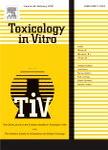版权所有:内蒙古大学图书馆 技术提供:维普资讯• 智图
内蒙古自治区呼和浩特市赛罕区大学西街235号 邮编: 010021

作者机构:NATL CANC CTRRES INST1-1 TSUKIJI 5 CHOMECHUO KUTOKYO 104JAPAN NCIDIV CANC ETIOLBETHESDAMD 20892
出 版 物:《TOXICOLOGY IN VITRO》 (体外毒理学)
年 卷 期:1987年第1卷第1期
页 面:45-48页
核心收录:
学科分类:1007[医学-药学(可授医学、理学学位)] 1001[医学-基础医学(可授医学、理学学位)] 10[医学]
基 金:Fund for the Entrustmenotf Research Program Ministry of Health and Welfare, MOHW
主 题:AαC 2-Amino-9 H -pyrido[2,3- b ]indole 4,8-DiMeIQx 2-amino-3,4,8-trimethylimidazo[4,5- f ]quinoxaline 7,8-DiMeIQx 2-amino-3,7,8-trimethylimidazo[4,5- f ]quinoxaline Glu-P-1 2-amino-6-methyldi-pyrido[1,2- a :3′,2′- d ]imidazole Glu-P-2 2-aminodi-pyrido[1,2- a :3′,2′- d ]imidazole IQ 2-amino-3-methyl-imidazo[4,5- f ]quinoline MeAαC 2-amino-3-methyl-9 H -pyrido[2,3- b ]indole MeIQ 2-amino-3,4-dimethyl-imidazo[4,5- f ]quinoline MeIQx 2-amino-3,8-dimethyl-imidazo[4,5- f ]quinoxaline Trp-P-1 3-amino-1,4-dimethyl-5 H -pyrido[4,3- b ]indole Trp-P-2 3-amino-1-methyl-5 H -pyrido[4,3- b ]indole
摘 要:The mutagenicity of a series of heterocyclic amines isolated from various cooked foods and from pyrolysates of amino acids and protein was assayed in Salmonella typhimurium TA98 in the presence of an S-9 fraction prepared from the liver of an untreated male rhesus monkey (Macaca mulatta). All the compounds showed mutagenicity, which ranged from 1 to 2500 revertants/mug chemical/mg S-9 protein. 2-Amino-3,4-dimethylimidazo[4,5-f]quinoline (MeIQ) showed the highest specific mutagenic activity, followed by 2-amino-3,7,8-trimethylimidazo[4,5-f]quinoxaline (7,8-DiMeIQx), 2-amino-3-methylimidazo[4,5-f]quinoline (IQ), 2-amino-3,4,8-trimethylimidazo[4,5-f]quinoxaline 4,8-DiMeIQx, 3-amino-1-methyl-5H-pyrido[4,3-b]indole (Trp-P-2), 3-amino-1,4-dimethyl-5H-pyrido[4,3-b]indole (Trp-P-1), 2-amino-3,8-dimethylimidazo[4,5-f]quinoxaline (MeIQx), 2-amino-6-methyldipyrido[1,2-a:3 ,2 -d]imidazole (Glu-P-1) and 2-amino-3-methyl-9H-pyrido[2,3-b]indole (MeAalphaC). 2-Amino-9H-pyrido[2,3-b]indole (AalphaC) and 2-aminodipyrido[1,2-a:3 ,2 -d]imidazole (Glu-P-2) also showed definite but weak mutagenicity. When compared with previously reported data, these specific mutagenic activities were very close to those of some heterocyclic amines assayed with the S-9 of human liver, slightly lower than those determined with the S-9 of untreated rat liver and much lower than those determined with S-9 from the liver of the untreated hamster or mouse. Most of the heterocyclic amines tested in this experiment have shown carcinogenicity in mice and rats. The experimental results now reported suggest the possible carcinogenicity of these heterocyclic amines in primates as well, including humans.